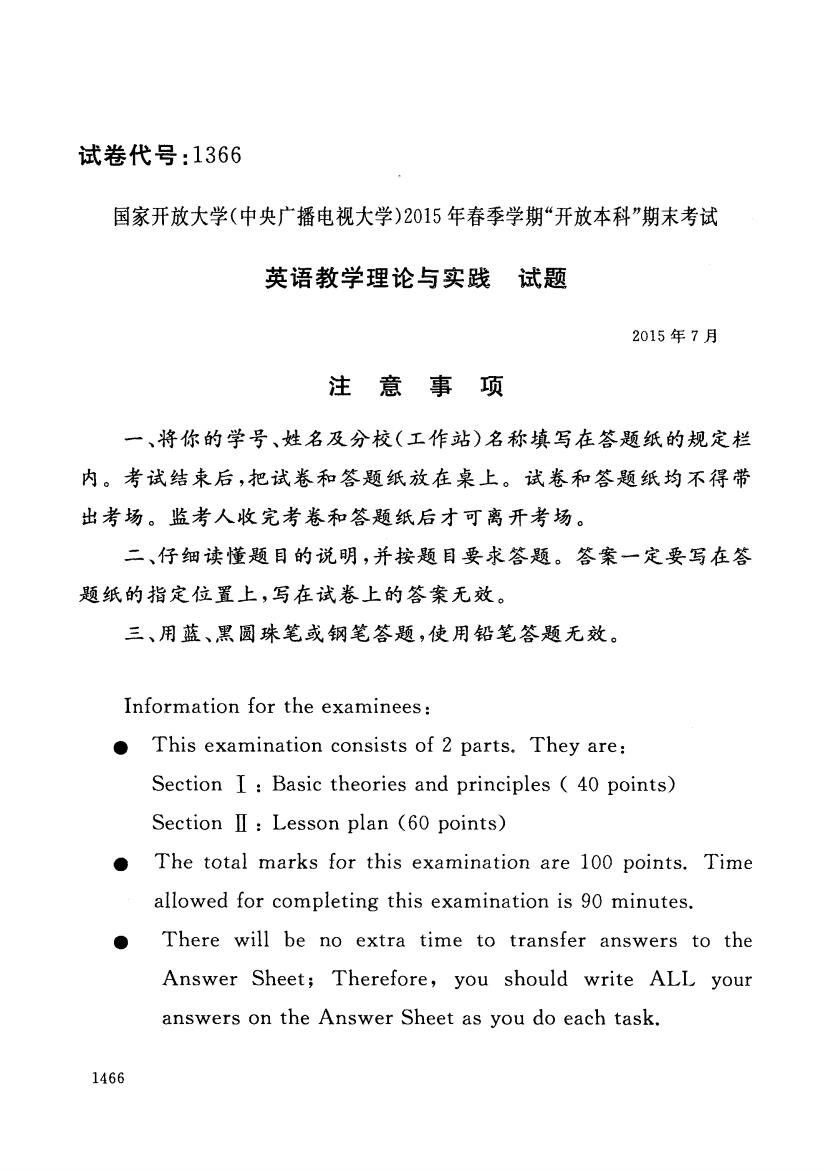
试卷代号:1366 国家开放大学(中央广播电视大学)2015年春季学期“开放本科”期末考试 英语教学理论与实践 试题 2015年7月 注意事项 一、将你的学号、姓名及分校(工作站)名称填写在答题纸的规定栏 内。考试结束后,把试卷和答题纸放在桌上。试卷和答题纸均不得带 出考场。监考人收完考卷和答题纸后才可离开考场。 二、仔细读懂题目的说明,并按题目要求答题。答案一定要写在答 题纸的指定位置上,写在试卷上的答案无效。 三、用蓝、黑圆珠笔或钢笔答题,使用铅笔答题无效。 Information for the examinees: This examination consists of 2 parts.They are: Section I Basic theories and principles 40 points) Section II:Lesson plan (60 points) The total marks for this examination are 100 points.Time allowed for completing this examination is 90 minutes. There will be no extra time to transfer answers to the Answer Sheet;Therefore,you should write ALL your answers on the Answer Sheet as you do each task. 1466
试卷代号 :1366 国家开放大学(中央广播电视大学 )2015 年春季学期"开放本科"期末考试 英语教学理论与实践 试题 2015 注意事项 一、将你的学号、姓名及分校(工作站)名称填写在答题纸的规定栏 内。考试结束后,把试卷和答题纸放在桌上。试卷和答题纸均不得带 出考场。监考人收完考卷和答题纸后才可离开考场。 二、仔细读懂题目的说明,并按题目要求答题。答案一定要写在答 题纸的指定位置上,写在试卷上的答案无效。 三、用蓝、黑圆珠笔或钢笔答题,使用铅笔答题无效。 Information for the examinees ~ • This examination consists of 2 parts. They are: Section 1 : Basic theories and principles ( 40 points) Section II : Lesson plan (60 points) • The total marks for this examination are 100 points. Time allowed for completing this examination is 90 minutes. • There will be no extra time to transfer answers to the Answer Sheet; Therefore , you should write ALL your answers on the Answer Sheet as you do each task. 1466
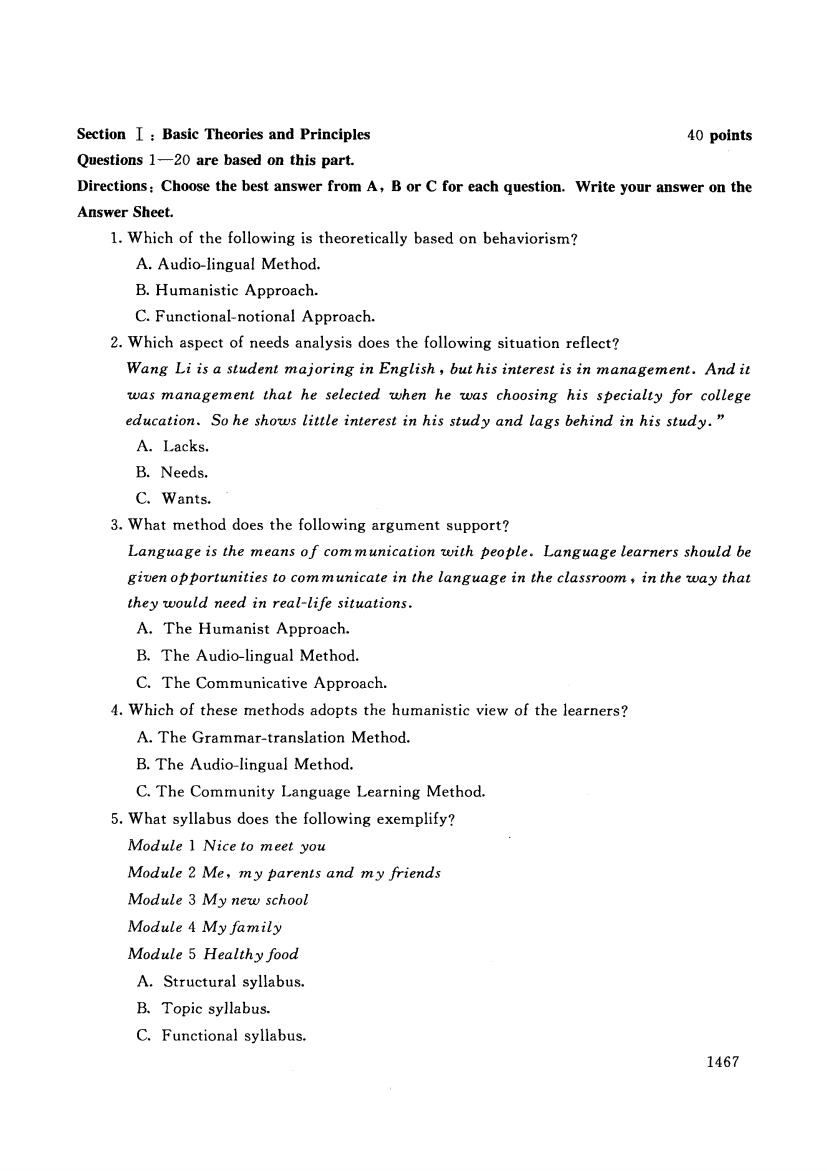
Section I:Basic Theories and Principles 40 points Questions 1-20 are based on this part. Directions:Choose the best answer from A,B or C for each question.Write your answer on the Answer Sheet. 1.Which of the following is theoretically based on behaviorism? A.Audio-lingual Method. B.Humanistic Approach. C.Functional-notional Approach. 2.Which aspect of needs analysis does the following situation reflect? Wang Li is a student majoring in English,but his interest is in management.And it was management that he selected when he was choosing his specialty for college education.So he shows little interest in his study and lags behind in his study." A.Lacks. B.Needs. C.Wants. 3.What method does the following argument support? Language is the means of communication with people.Language learners should be given opportunities to communicate in the language in the classroom,in the way that they would need in real-life situations. A.The Humanist Approach. B.The Audio-lingual Method. C.The Communicative Approach. 4.Which of these methods adopts the humanistic view of the learners? A.The Grammar-translation Method. B.The Audio-lingual Method. C.The Community Language Learning Method. 5.What syllabus does the following exemplify? Module 1 Nice to meet you Module 2 Me,my parents and my friends Module 3 My new school Module 4 My family Module 5 Healthy food A.Structural syllabus B.Topic syllabus. C.Functional syllabus. 1467
Sectioo 1 : Basic Theories aod Priociples Questioos 20 are based 00 this part. 40 poiots Directioos: Choose the best aoswer from A. B or C for each questioo. Write your aoswer 00 the Aoswer Sheet. 1. Which of the following is theoretically based on behaviorism? A. Audio-lingual Method. B. H umanistic Approach. C. Functional-notional Approach. 2. Which aspect of needs analysis does the following situation reflect? Wang Li is a student majoring in English. but his interest is in management. And it was man gement that he selected when he was choosing his specialty for college education. So he shows little interest in his study nd lags behind in his study. " A. Lacks. B. Needs. C. Wants. 3. What method does the following argument support? Language is the means of communication with peo le. Language learners should be given 0ρ portunities to com m unicate in the language in the classroom. in the ay that they would need in real-life situations. A. The H umanist Approach. B. The Audio-lingual Method. C. The Communicative Approach. 4. Which of these methods adopts the humanistic view of the learners? A. The Grammar-translation Method. B. The Audio-lingual Method. C. The Community Language Learning Method. 5. What syllabus does the following exemplify? Module 1 Nice to meet you Module 2 Me , my parents and my iends Module 3 My new school Module 4 My family Module 5 Healthy food A. Structural syllabus. B. Topic syllabus. C. Functional syllabus. 1467
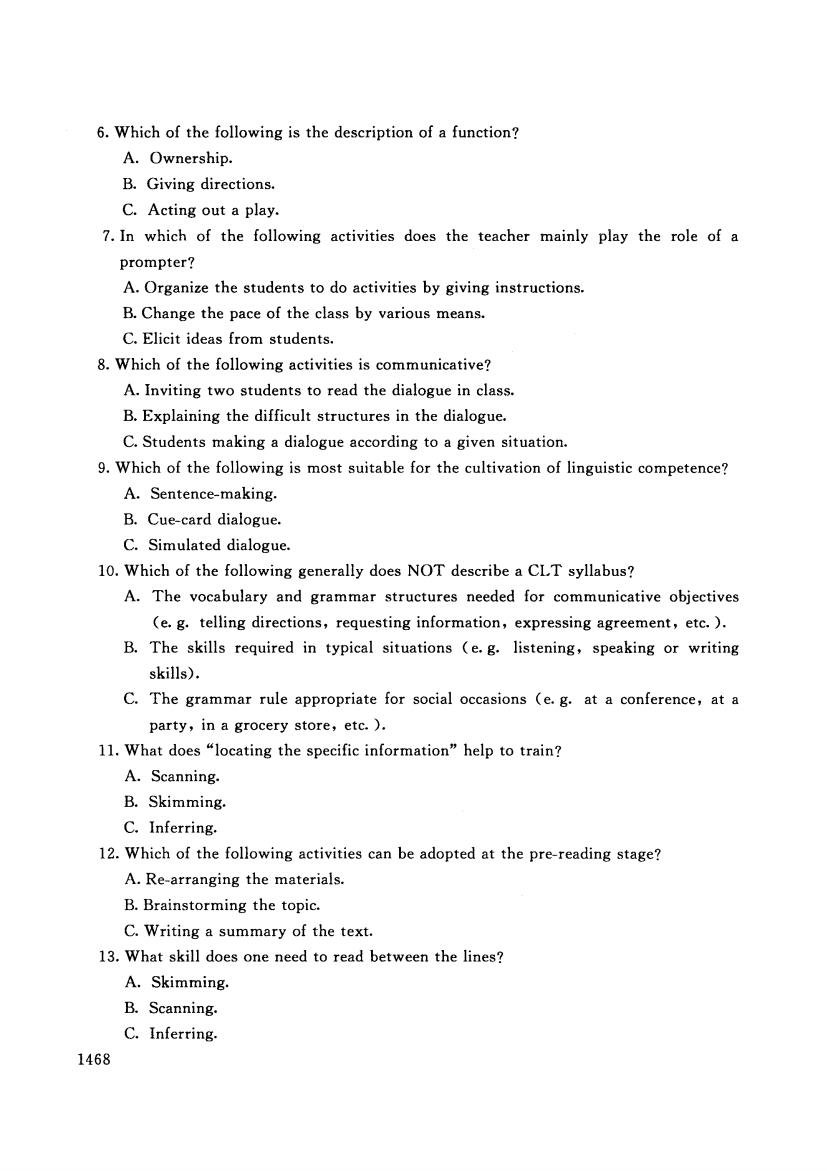
6.Which of the following is the description of a function? A.Ownership. B.Giving directions. C.Acting out a play. 7.In which of the following activities does the teacher mainly play the role of a prompter? A.Organize the students to do activities by giving instructions. B.Change the pace of the class by various means. C.Elicit ideas from students. 8.Which of the following activities is communicative? A.Inviting two students to read the dialogue in class. B.Explaining the difficult structures in the dialogue. C.Students making a dialogue according to a given situation. 9.Which of the following is most suitable for the cultivation of linguistic competence? A.Sentence-making. B.Cue-card dialogue. C.Simulated dialogue. 10.Which of the following generally does NOT describe a CLT syllabus? A.The vocabulary and grammar structures needed for communicative objectives (e.g.telling directions,requesting information,expressing agreement,etc.). B.The skills required in typical situations (e.g.listening,speaking or writing skills). C.The grammar rule appropriate for social occasions (e.g.at a conference,at a party,in a grocery store,etc.). 11.What does "locating the specific information"help to train? A.Scanning. B.Skimming. C.Inferring. 12.Which of the following activities can be adopted at the pre-reading stage? A.Re-arranging the materials. B.Brainstorming the topic. C.Writing a summary of the text. 13.What skill does one need to read between the lines? A.Skimming. B.Scanning. C.Inferring. 1468
6. Which of the following is the description of a function? A. Ownership. B. Giving directions. C. Acting out a play. 7.In which of the following activities does the teacher mainly play the role of a prompter? A. Organize the students to do activities by giving instructions. B. Change the pace of the class by various means. C. Elicit ideas from students. 8. Which of the following activities is communicative? A. Inviting two students to read the dialogue in class. B. Explaining the difficult structures in the dialogue. C. Students making a dialogue according to a given situation. 9. Which of the following is most suitable for the cultivation of linguistic competence? A. Sentence-making. B. Cue card dialogue. C. Simulated dialogue. 10. Which of the following generally does NOT describe a CLT syllabus? A. The vocabulary and grammar structures needed for communicative objectives (e. g. telling directions, requesting information , expressing agreement. etc. ). B. The skills required in typical situations (e. g. listening , speaking or writing skills). C. The grammar rule appropriate for social occasions (e. g. at a conference , at a party , in a grocery store , etc. ). 11. What does "locating the specific information" help to train? A. Scanning. B. Skimming. C. Inferring. 12. Which of the following activities can be adopted at the pre-reading stage? A. Re-arranging the materials. B. Brainstorming the topic. C. Writing a summary of the text. 13. What skill does one need to read between the lines? A. Skimming. B. Scanning. C. Inferring. 1468
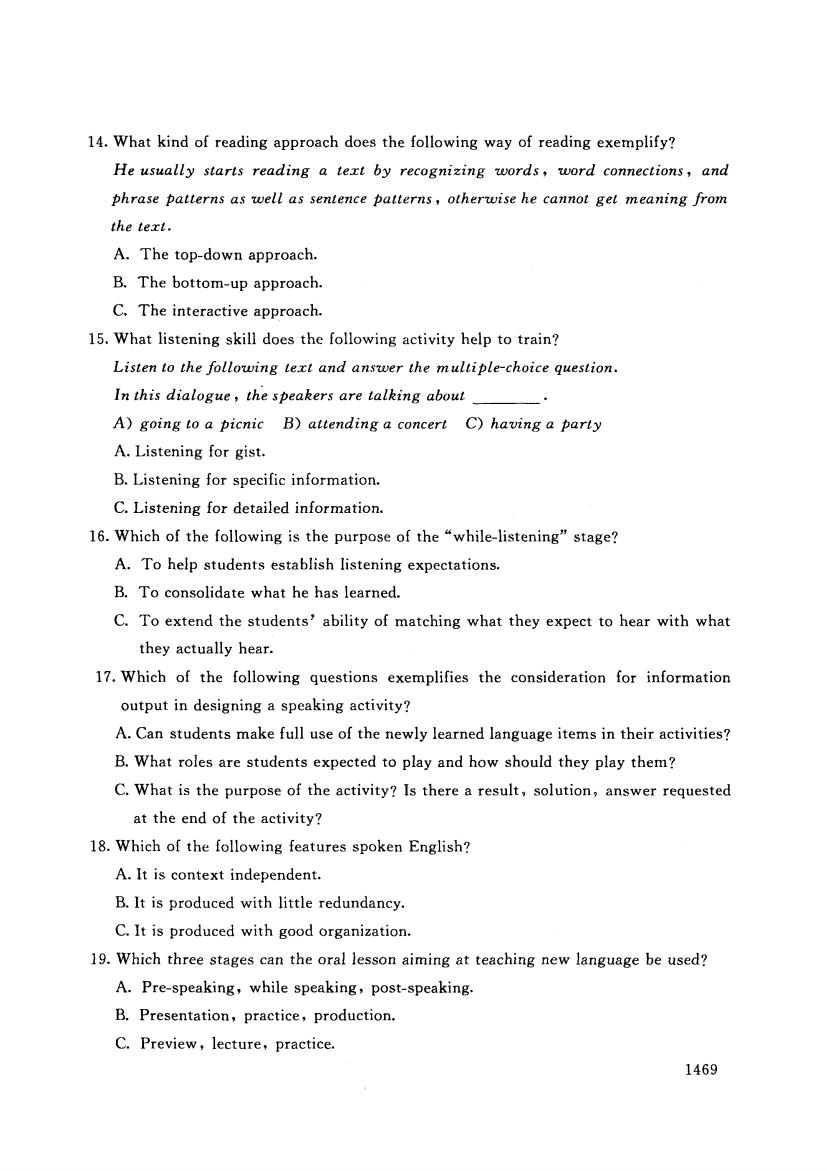
14.What kind of reading approach does the following way of reading exemplify? He usually starts reading a text by recognizing words,word connections,and phrase patterns as well as sentence patterns,otherwise he cannot get meaning from the text. A.The top-down approach. B.The bottom-up approach. C.The interactive approach. 15.What listening skill does the following activity help to train? Listen to the following text and answer the multiple-choice question. In this dialogue,the speakers are talking about A)going to a picnic B)attending a concert C)having a party A.Listening for gist. B.Listening for specific information. C.Listening for detailed information. 16.Which of the following is the purpose of the "while-listening"stage? A.To help students establish listening expectations. B.To consolidate what he has learned. C.To extend the students'ability of matching what they expect to hear with what they actually hear. 17.Which of the following questions exemplifies the consideration for information output in designing a speaking activity? A.Can students make full use of the newly learned language items in their activities? B.What roles are students expected to play and how should they play them? C.What is the purpose of the activity?Is there a result,solution,answer requested at the end of the activity? 18.Which of the following features spoken English? A.It is context independent. B.It is produced with little redundancy. C.It is produced with good organization. 19.Which three stages can the oral lesson aiming at teaching new language be used? A.Pre-speaking,while speaking,post-speaking. B.Presentation,practice,production. C.Preview,lecture,practice. 1469
14. What kind of reading approach does the following way of reading exemplify? He usually starts reading a text by recognizing words , word connections , and phrase patterns as well as sentence atterns , otherwise he cannot get meaning from the text. A. The top-down approach. B. The bottom-up approach. C. The interactive approach. 15. What listening skill does the following activity help to train? Listen to the following text and answer the multiple-choice question. In this dialogue , the speakers are talking about 一-一一-一. A) going to a picnic B) attending a concert C) having a arty A. Listening for gist. B. Listening for specific information. C. Listening for detailed information. 16. Which of the following is the purpose of the "while-listening" stage? A. To help students establish listening expectations. B. To consolidate what he has learned. C. To extend the students' ability of matching what they expect to hear with what they actually hear. 17. Which of the following questions exemplifies the consideration for information output in designing a speaking activity? A. Can students make full use of the newly learned language items in their activities? B. What roles are students expected to play and how should they play them? C. What is the purpose of the activity? Is there a result , solution , answer requested at the end of the activity? 18. Which of the following features spoken English? A. It is context independent. B. It is produced with little redundancy. C. It is produced with good organization. 19. Which three stages can the orallesson aiming at teaching new language be used? A. Pre-speaking , while speaking , post-speaking. B. Presentation , practice , production. C. Preview. lecture , practice. 1469
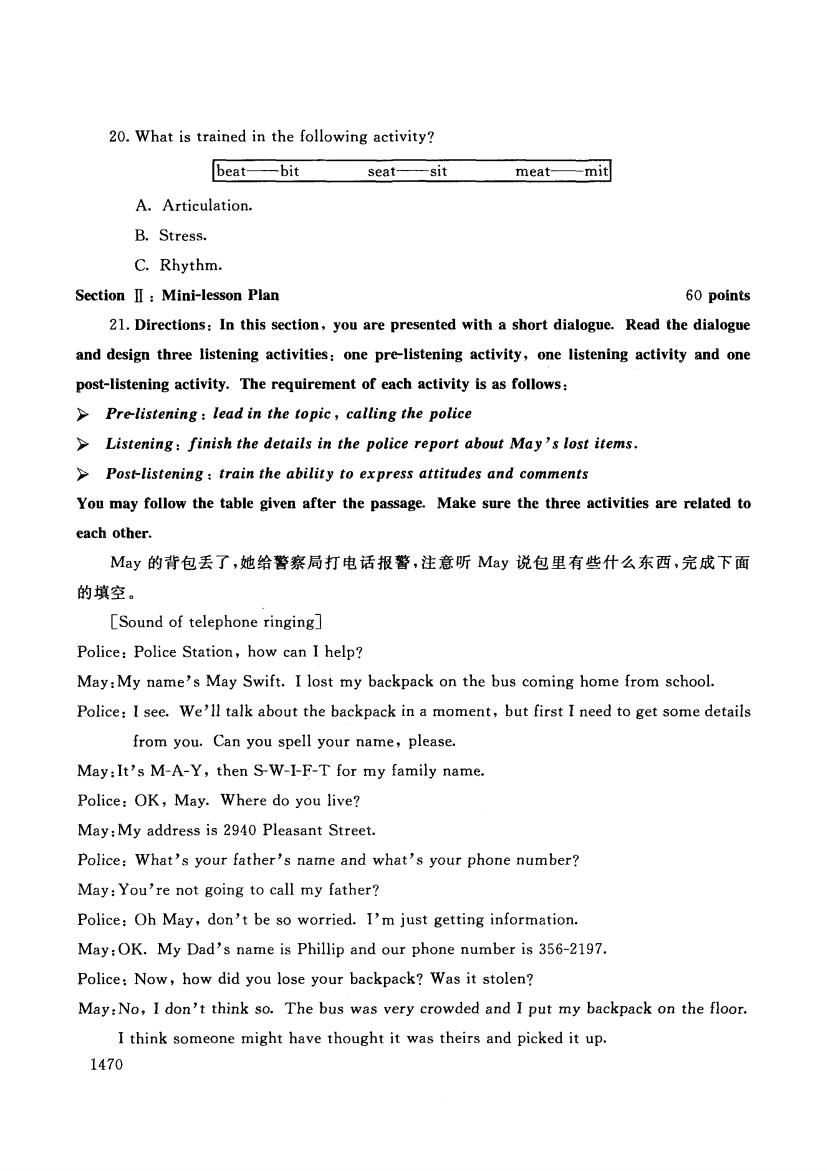
20.What is trained in the following activity? beat—bit seat—sit meat-mit A.Articulation. B.Stress. C.Rhythm. SectionⅡ:Mini-lesson Plan 60 points 21.Directions:In this section,you are presented with a short dialogue.Read the dialogue and design three listening activities:one pre-listening activity,one listening activity and one post-listening activity.The requirement of each activity is as follows: >Pre-listening:lead in the topic,calling the police >Listening:finish the details in the police report about May's lost items. Post-listening:train the ability to express attitudes and comments You may follow the table given after the passage.Make sure the three activities are related to each other. May的背包丢了,她给警察局打电话报警,注意听May说包里有些什么东西,完成下面 的填空。 [Sound of telephone ringing] Police:Police Station,how can I help? May:My name's May Swift.I lost my backpack on the bus coming home from school. Police:I see.We'll talk about the backpack in a moment,but first I need to get some details from you.Can you spell your name,please. May:It's M-A-Y,then S-W-I-F-T for my family name. Police:OK,May.Where do you live? May:My address is 2940 Pleasant Street. Police:What's your father's name and what's your phone number? May:You're not going to call my father? Police:Oh May,don't be so worried.I'm just getting information. May:OK.My Dad's name is Phillip and our phone number is 356-2197. Police:Now,how did you lose your backpack?Was it stolen? May:No,I don't think so.The bus was very crowded and I put my backpack on the floor. I think someone might have thought it was theirs and picked it up. 1470
20. What is trained in the following activity? Ibeat--bit seat一一一-Slt meat二叫 A. Articu1ation. B. Stress. C. Rhythm. tion II : Mini-Iesson Plan 60 points 21. Directions: In this scction , you are presented with a short dialogue. Read the dialogue and design three Iistening activities: one pre-Iistening activity , one Iistening activity and one post-Iistening activity. The requirement of each activity is as follows: ~ Pre-listening: lead in the topic , calling the police ~ Listening: finish the details in the police report about May's lost items. )> Post-listening: train the ability to express attitudes and comments You may follow the table given after the passage. Make sure the three activities are related to each other. May 的背包丢了,她给警察局打电话报警,注意听 May 说包里有些什么东西,完成下面 的填空。 [Sound of te1ephone ringingJ Police: Po1ice Station , how can I he1p? May: My name' s May Swift. I 10st my backpack on the bus coming home from school. Police: I see. We'll talk about the backpack in a moment , but first I need to get some details from you. Can you spell your name , please. May: It's M-A-Y. then S-W-I-F-T for my family name. Police: OK , May. Where do you live? May: My address is 2940 P1easant Street. Police: What's your father's name and what's your phone number? May: You' re not going to call my father? Police: Oh May , don't be so worried. I'm just getting information. May: OK. My Dad' s name is Phillip and our phone number is 356-2197. Police: Now , how did you lose your backpack? Was it stolen? May:No. 1 don't think so. The bus was very crowded and 1 put my backpack on the floor. I think someone might have thought it was theirs and picked it up. 1470

Police:That's possible.What color was it? May:It's red with a little bit of blue. Police:That's a little unusual.Can you tell me what was in it? May:I know I had a schoolbook,my history book.There was my bus ticket for the month of April.Oh,there was my notebook for English class.My homework was in that.I had some really great photos of my friends at my birthday party.That was last month. Er...oh yeah!I had the key to my house.My parents will be so angry when they learn I've lost that.They both work late and I can't get in without my key.Then there was a magazine about exercises for girls and my P.E.clothes.We wear T-shirts and shorts in the school colors of red and blue.That's about it. Police:Was there any money?How about valuables like earrings? May:No,my money was in my coat and I don't wear earrings. Police:That's good.May,try not to worry.People lose things on the buses all the time. Someone might even bring it to us today.I'll call if that happens. May:Thank you. Police Report Things in her backpack Description a schoolbook history book (1) for month of April notebook (2) (3) friends at my birthday party (4) to my house magazine (5) (6) red and blue T-shirt and shorts Activity 1 (Pre-listening) Objectives Classroom organization Teaching aid 1) Procedure 2) 3) Transition (how to relate to the following activity) 1471
Police: That' s possible. What color was it? May: It's red with a little bit of blue. Police: That' s a little unusual. Can you tell me what was in it? May :I know 1 had a schoolbook , my history book. There was my bus ticket for the month of April. Oh , there was my notebook for English class. My homework was in that. 1 had some really great photos of my friends at my birthday party. That was last month. Er. .. oh yeah! 1 had the key to my house. My parents will be so angry when they learn l' ve lost that. They both work late and 1 can' t get in without my key. Then there was a magazine about exercises for girls and my P. E. clothes. We wear T-shirts and shorts in the school colors of red and blue. That' s about it. Police: Was there any money? How about valuables like earrings? May: No , my money was in my coat and 1 don't wear earrings. Police: That's good. May , try not to worry. People lose things on the buses al1 the time. Someone might even bring it to us today. l' 11 call if that happens. May: Thank you. Police Report Things in her backpack Description a schoolbook history book (1) for month of April notebook (2) (3) friends at my birthday party (4) to my house magazme (5) (6) red and blue T-shirt and shorts Activity 1 (Pre-listening) Objectives Classroom organtzatlOn Teaching aid 1) Procedure 2) 3) Transition (how to relate to the fo11owing activity) 1471

Activity 2 (listening) Objectives Classroom organization Teaching aid Transition (how to relate to the former activity) 1) Procedure 2) 3) Transition (how to relate to the following activity) Activity 3 (Post-listening) Objectives Classroom organization Teaching aid Transition how to relate to the former activity) 1) Procedure 2) 3) Backup plan: (1)Predicted problems (2)Possible solutions 1472
Activity 2 (listening) Objectives Classroom orgamzatlOn Teaching aid Transition (how to relate to the former activity) Procedure Transition (how to relate to the following activity) Activity 3 (Post-Iistening) Objectives Classroom orgamzatlOn Teaching aid Transition (how to relate to the former activity) Procedure Backup plan: (1) Predicted problems (2)Possible solutions 1472 1) 2) 3) 1) 2) 3)

试卷代号:1366 座位号■■ 国家开放大学(中央广播电视大学)2015年春季学期“开放本科”期末考试 英语教学理论与实践 试题答题纸 2015年7月 题 号 Section Section II 总分 分 数 得分 评卷人 Section I:Basic Theories and Principles (40 points) 1. 2. 3. 4. 5. 6. 7. 日 9. 10. 11. 12. 13. 14. 15. 16. 17. 18. 19. 20. 得分 评卷人 SectionⅡ:Lesson Plan (60 points) 21.Activity 1 Objectives: Classroom organization: Teaching aid: Assumed time: Procedure: Transition:(how to relate to the following activity) 1473
试卷代号 :1366 座位号 国家开放大学(中央广播电视大学 )2015 年春季学期"开放本科"期末考试 英语教学理论与实践 试题答题纸 1. 6. 11. 16. 21. Activity 1 Objectives: 2. 7. 12. 17. Section 1 : Basic Theories and Principles 3. 13. 18. Section II : Lesson Plan 4. 9. 14. 19. Classroom organiza tion: Teaching aid: Assumed time: Transition: (how to relate to the following activity) 5. 10. 15. 20. 2015 (40 points) (60 points) 1473
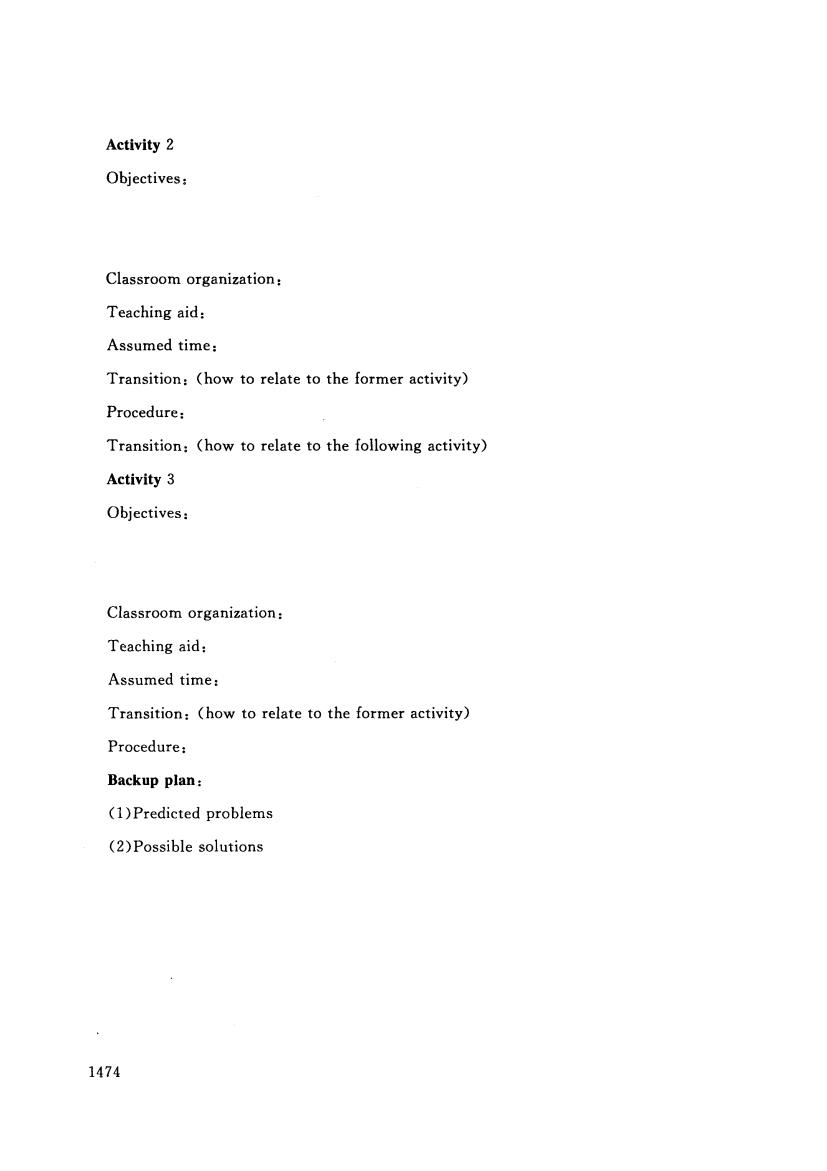
Activity 2 Objectives: Classroom organization: Teaching aid: Assumed time: Transition:(how to relate to the former activity) Procedure: Transition:(how to relate to the following activity) Activity 3 Objectives: Classroom organization: Teaching aid: Assumed time: Transition:(how to relate to the former activity) Procedure: Backup plan: (1)Predicted problems (2)Possible solutions 1474
Activity 2 Objectives: Classroom organization: T eaching aid: Assumed time: Transition: (how to relate to the former activity) Procedure , Transition: (how to relate to the following activity) Activity 3 Objectives: Classroom organization: Teaching aid: Assumed time: Transition: (how to relate to the former activity) Procedure: Backup plan: (1) Predicted problems (2)Possible solutions 1474
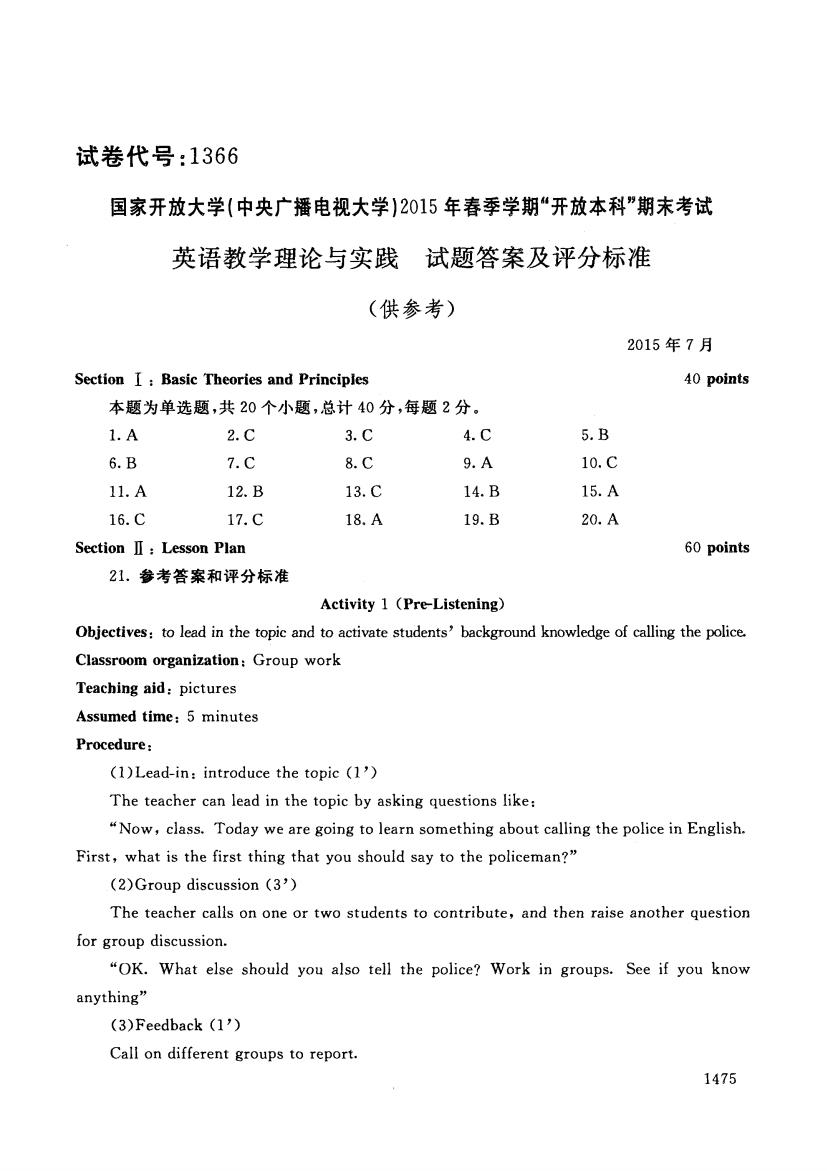
试卷代号:1366 国家开放大学(中央广播电视大学)2015年春季学期“开放本科”期末考试 英语教学理论与实践 试题答案及评分标准 (供参考) 2015年7月 Section I:Basic Theories and Principles 40 points 本题为单选题,共20个小题,总计40分,每题2分。 1.A 2.C 3.C 4.C 5.B 6.B 7.C 8.C 9.A 10.C 11.A 12.B 13.C 14.B 15.A 16.C 17.C 18.A 19.B 20.A SectionⅡ:Lesson Plan 60 points 21.参考答案和评分标准 Activity 1 (Pre-Listening) Objectives:to lead in the topic and to activate students'background knowledge of calling the police. Classroom organization:Group work Teaching aid:pictures Assumed time:5 minutes Procedure: (1)Lead-in:introduce the topic (1') The teacher can lead in the topic by asking questions like: "Now,class.Today we are going to learn something about calling the police in English. First,what is the first thing that you should say to the policeman?" (2)Group discussion (3') The teacher calls on one or two students to contribute,and then raise another question for group discussion. "OK.What else should you also tell the police?Work in groups.See if you know anything” (3)Feedback (1') Call on different groups to report. 1475
试卷代号 :1366 国家开放大学{中央广播电视大学 )2015 年春季学期"开放本科"期末考试 英语教学理论与实践 试题答案及评分标准 (供参考) Sectíon 1 : Basic Theories and Principles 本题为单选题,共 20 个小题,总计 40 分,每题 分。 2015 40 points 1. A 6. B 11. A 16. C 2. C 7. C 12. B 17. C 3. C 8. C 13. C 18. A BB CA 5.B 10. C 15. A 20. A Section n : Lesson Plan 1.参考答案和评分标准 60 points Activity 1 (Pre-Listening) Objectives: to lead in the topic and to activate students' background knowledge of calling the police. Classroom organization: Group work Teaching aid: pictures Assumed time , 5 minutes Procedure , (1) Lead-in: introduce the topic (1') The teacher can lead in the topic by asking questions like: "Now, class. Today we are going to learn something about calling the police in English. First , what is the first thing that you should say to the policeman?" (2)Group discussion (3') The teacher cal1s on one or two students to contribute , and then raise another question for group discussion. "OK. What else should you also tel1 the police? Work in groups. See if you know anything" (3)Feedback (1 ') Call on different groups to report. 1475